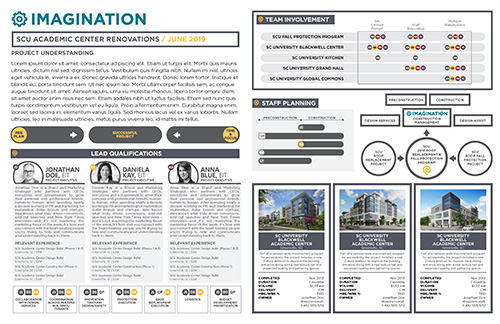If there is a single truth about marketing and business development in the architecture, engineering, construction (AEC), and environmental industry, it is this:
Everyone hates proposals!
Owners and reviewers hate proposals. Why would someone enjoy sitting there, days on end, reading lengthy proposals that all look alike and essentially say the exact same thing?
Marketers hate proposals. Nothing sucks the creative life out of a marketer like pulling together a statement of qualifications based upon a highly prescriptive request. And when confined to a standardized form, well, to a creative personality that’s their definition of hell!
And now imagine reviewing or preparing proposals day after day, year after year….
Why do we do this to ourselves? What is wrong with us?
Sure, as an industry we’ve talked about the need to do something different for years. But what has really changed? Maybe the graphics are better than they were a decade ago. Maybe we use wire bindings or three-ring binders instead of those horrific plastic comb bindings. But we include the same information that we’ve always included – just updated (hopefully). We put forth a vomit of narrative that never gets read or remembered, and waste a lot of time in the process.
As we slog through another damn proposal, we keep thinking, “There has to be a better way.”
A Better Way
Could there actually be a better way? Could there be light at the end of the proposal tunnel?
The construction industry is filled with waste – and I’m not just referring to construction debris. Construction productivity has seen incremental advances over the past few decades, while the general economy has seen much greater productivity increases and manufacturing has knocked it out of the park. But the AEC industry is filled with duplicate efforts, communication silos, lack of interconnectivity, archaic techniques, and team members with varied knowledge or capabilities.
This is why lean construction has been gaining in popularity. Lean construction focuses on waste elimination, value generation, and continuous improvement. The Lean Construction Institute is a non-profit organization focused on bringing lean concepts to the construction industry, including a transformation of the wasteful proposal process.
Ann M. Leiner, founder and Chief Connection Officer of Stacey and Associates, a Pennsylvania-based business growth consultancy focused on the design and construction industry, thinks it’s about time. For several years she’s been helping AEC firms, as well as construction owners, understand the value of lean proposal processes. “What has really changed over the past 30 years?” she asks. “A cover letter, table of contents, resumes, relevant projects, scope of work, fee for services, and references. We’ve been delivering the same proposals time and again and no one is happy about it – not the owners reviewing the proposals, and not the marketing teams pulling them together.”

Ann M. Leiner
One of the time-saving, waste-eliminating approaches promoted by the Lean Construction Institute is use of an A3 for conveying important information.
“The A3 offers a new way of presenting traditional information that is required for professional and construction selections,” she says. “One or two A3 pages can replace a 20 or 30-page boilerplate proposal – the type that we’ve all seen and used. It really is possible to create a winning proposal with fewer than 2000 words!”
Some sophisticated owners are already embracing the A3 approach for proposals and more.
Ann notes that “Owners who have used A3s love it – the approach reduces the amount of time that they spend reading big, thick proposals, allowing for easier reviews.”
Furthermore, when companies are limited to just one or two 11”x17” pages, they are forced to focus their efforts on the things that really matter to the client.
As someone who’s worked on both the AEC-side and owner-side of the A3 process, Ann continually sees the benefits of the approach. In fact, she’s witnessed use of A3 submissions throughout the duration of a project.
“I’ve seen A3s in lieu of meeting minutes. Design and construction teams are creating dashboards to provide regular project updates. All the project stakeholders get together and agree upon a format and critical content, like work performed during the period, how it went, unresolved issues, forthcoming work, required decisions from the owner or other team members, budget, schedule, conditions of satisfaction, and more. The whole idea here is to streamline the reporting and sharing of the most critical project information. An A3 facilitates this exchange.”
“Some owners are also incorporating the more traditional A3 lean decision-making process during the programming stage to help determine how an option, or multiple options, will turn out,” she adds.
Ann actually introduced me to the A3 process two years ago. Since then I’ve seen it required for a number of proposals for universities, health care systems, and even governmental agencies. In fact, a recent Request for Proposals for a state agency looking to retain multiple construction managers for open-end contracts limited proposals to just two A3 pages, submitted electronically. The owner encouraged submitters to get creative: “The content may be formatted and organized in whatever manner the proposer desires. The proposer may place whatever content they desire on the A3. This allows the proposer to use their imagination and best judgement in ‘selling’ their firm’s experience, qualifications, capabilities, etc.”
A major university recently released a Request for Qualifications for construction managers for a new $25 million dollar building. Their RFQ specifically stated the following:
If your firm is interested in pursuing this project, please convince [The University] that you are highly qualified to perform Construction Management services on this type of project. Please respond on two (2) single- sided A3’s (11 x 17) only, in pdf format, with no cover letter:
Please provide evidence of the following (at a minimum):
a. Recent experience with projects of this size, type, and complexity
b. Availability of experienced and exceptional staff
c. Ability to apply Target Value Delivery and other value-adding lean principles to the project
d. Virtual reality and technology capabilities
e. Established QA/QC protocols during design and construction
f. Prevention through Design experience
Clearly, some owners are beginning to embrace the simplicity of the A3 proposal.
During her time helping AEC firms and owners through the A3 submission process, Ann has seen the quality of submissions evolve: “While some firms come in very text-heavy with limited graphical elements, others are able to convey the most important points using infographics, charts, images, and icons. Some firms are now even embedding links, maybe to content on their website, or maybe even to customized videos with direct messages to the project owners. This can be an extremely effective approach to differentiation.”

A hypothetical A3 submission. To download this and access more information, surf to http://www.staceyandassociates.com/a3-works.
Recently, Ann has even seen some construction managers requiring A3 proposals from their subcontractors, and she fully expects this trend to continue. “We need to think about how we get information in every other aspect of our lives and how we make our buying decisions. The old way of doing proposals is simply not relevant anymore.”
Advice from Owners
In working with construction owners and reviewers, Ann has experienced first-hand elements of A3s that were not well received.
“Full bleeds are a no-go,” she recommends. “A3s should be printable, even if the purpose of a digital submission is to eliminate printing. Most owners print them out.”
Another common mistake occurs when there are multiple A3 pages. Ann says that “Firms often don’t identify themselves on second or third pages, and the printed pages may get separated. Furthermore, firms often don’t list the project name on every page, again creating a problem if the printed pages become separated.”
A3 design is another issue of contention. Ann advises firms to design their A3 with the evaluation criteria in mind. “The A3 is brilliant in that it allows owners to see if the AEC firms are paying attention. Do they really understand the most critical elements of a project? Are the A3s highly targeted to the project and the owner? Or are they boilerplate elements shoe-horned onto an 11x17?”
The use of graphics, infographics, text boxes, illustrations, charts, symbols, pull-quotes, and other visuals draws attention to key value messages. Too much narrative text distracts from these messages, and makes it more difficult on the reviewers. One client lamented to Ann that they received an A3 proposal from a reputable firm but they felt like they were being “shouted at” and, upon further review, the proposal was nothing but graphical boilerplate that didn’t even address the project. Just because a firm only has to create a one or two page proposal doesn’t mean that the firm should be spending less time on it. Not all A3 proposals are created equal, and the firms that spend a lot of time and effort on their submissions rise to the top.
The A3 process is a two-way street, however, and Ann has seen owners lacking clarity in their proposal requirements, resulting in myriad responses that didn’t address the true project issues. “Owners need to be very deliberate in what they are asking. Don’t ask for something generic like, ‘What’s your approach to QA/QC?’ as this will result in boilerplate. Rather, ask ‘How will you ensure the accuracy of bidding documents on this project before we go out to bid?’ Be specific. Allow the proposers to focus on the key issues you are looking to see addressed.”
Will Lean concepts like A3 proposals become the norm? Time will tell. But Ann is spot-on when she says that everyone in the industry has been complaining about the proposal process for decades, but nothing ever seems to improve. When the Federal Government evolved from the Standard Form 255 to the Standard Form 330, that was a major change, but not necessarily an improvement – it was just a different way of submitting the same information! Some of us, myself included, feel like we’ve wasted several years of our careers on uninspiring proposals.
Ann feels bullish on the future, and she’s been out presenting about A3 proposals thinking to different owner organizations. She’s never encountered stern resistance. Some owners aren’t quite sure how A3s could fit into their process, while others are very intrigued but have to deal with internal policies and politics to make such seismic changes. Yet owners are interested and open the idea, ensuring that the implementation of A3 proposal processes will continue, at least until a better alternative presents itself.
Contact Ann Leiner
Ann M. Leiner
Chief Connection Officer
Stacey and Associates
814-934-7000
Ann@StaceyAndAssociates.com
Connect with Scott
LinkedIn: https://www.linkedin.com/in/scottdbutcher
Twitter: https://www.twitter.com/scottdbutcher
Email: sbutcher@aecumen.com
Website: http://www.aecumen.com


Post a comment to this article
Report Abusive Comment